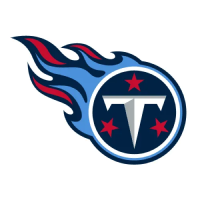The end of each NFL season brings a new wave of critical decisions for franchises across the league, one of them being whether or not to exercise the fifth-year options on the team’s previous first-round draft selections. With the current collective bargaining agreement, NFL teams must make this decision after a player’s third season in the NFL. At that point, there is enough of a sample size in many cases to feel confident about that decision. But with the new standards for tiered fifth-year options based on availability and performance on the field, there is certainly more strategy to making that executive decision than there has been in years past.
But not all fifth-year option choices are hard in terms of whether or not they should be exercised. The Kansas City Chiefs had little to think about when determining if Patrick Mahomes was going to have his fifth-year option exercised, for example. Yet there’s a different layer of strategy to explore for the slam-dunk options, too.
Should that player ever see a snap of the fifth year of his rookie contract? If a player enters the league and quickly becomes a star, the risk of drawing out a second contract beyond when it is first eligible to be signed is that you’ll oftentimes pay much more as a player continues to play at a high level over their fourth and fifth years in the league.
So which talents from the 2019 NFL Draft, which will be the next to have their names called for fifth-year options after the end of the 2021-2022 NFL season, should have not just an exercised option on their radar, but also a second contract? Here are three members of the 2019 first round who should already be ready to skip playing on their fourth or fifth years of a rookie deal and be ready for a major payday next offseason:
IDL Quinnen Williams (No. 3 overall)
The instability of the Arizona Cardinals with coaching questions regarding Kliff Kingsbury and the injury to Nick Bosa in San Francisco are enough to have me bypassing each of the top two choices of the 2019 NFL Draft in terms of getting their second contracts expedited. A top-flight quarterback contract is a major investment and the Cardinals would be well within their rights to want to collect more information on Murray’s trajectory. Bosa will need to prove he can stay healthy.
But Williams? If he produces an encore of his performance in 2020, there’s no reason the Jets shouldn’t already be thinking about a second contract and locking in one of their young cornerstones of the roster.
Williams started the year slow in 2020 after a relatively unproductive rookie season, but he was spectacular down the stretch and finished the year as one of the most disruptive interior defenders in all of football. The Jets are currently projected to own the NFL’s third-highest cap space for 2022, so finding the financial wiggle room won’t be a problem. Getting Williams’ new deal on the books early will allow the team more foresight in navigating additional big contracts and brace for managing their cap commitments and guaranteed money with one of their blue-chip players already locked up long term.
TEs T.J. Hockenson, Detroit Lions (No. 8 overall) & Noah Fant, Denver Broncos (No. 20 overall)
I’m willing to bucket both of the Iowa tight ends together here because these two teams should be racing to get the next big contract finalized at the tight end position. Both Hockenson and Fant enjoyed productive sophomore seasons in the NFL, combining to offer their respective teams 1,396 receiving yards and nine touchdowns between the two of them. Fant played through injuries for a portion of the season but nevertheless finished top eight in the league in targets, receptions, and yards for tight ends.
So why am I including them both? Because whichever team gets the extension ironed out first wins. Both are plus tight ends that provide value in both the run and the pass game. And the tight end financial market is rapidly evolving across the league—San Francisco’s George Kittle and Kansas City’s Travis Kelce saw to that when they reset the spending ceiling for the position by approximately 50% last summer. In the time that has passed, Jonnu Smith and Hunter Henry got monster contracts from the New England Patriots to help bridge the gap—but there’s a storm brewing.
Las Vegas Raiders tight end Darren Waller will earn under $6.5M this season and that extension feels inevitable. So between Waller, Miami Dolphins tight end Mike Gesicki, and the duo of 2019 first-round tight ends from Iowa, there’s going to be a lot of spending over the next 12-18 months at the position.
You’re going to want to get in on this spending spree on the ground floor. So Denver and Detroit need to confirm their beliefs this season and then make sure they’re not signing the second deal and allowing the player’s camp to use the *other* contract as leverage to try to coax a bigger cap hit. It is better to set the market than to pay it.
SAF Darnell Savage, Green Bay Packers (No. 21 overall)
Packers safety Darnell Savage has performed well throughout the majority of his young NFL career, but his play down the stretch for the Packers to close the 2020 regular season was on a different level. Savage logged all four of his interceptions and six of his seven passes defensed on the season between Week 10 and the close of the season, and the second-year safety finished the season with a passer rating allowed of 63.0 on 33 targets.
Savage plays a role that allows him to shine on a number of different fronts. He took more than 200 snaps in the box and an additional 200 snaps in the slot last season according to Pro Football Focus in addition to his primary role as the high-post safety in Green Bay’s defense.
That amount of versatility paired with swelling ball production makes Savage a potential game-changing defender who needs to be paid accordingly. If the Packers are going to survive the looming transition away from Aaron Rodgers, whether it comes in 2021 or in 2022, they’ll need to retain their other notable talent.
Savage is a prospect on the rise and his position, like the tight end position, is one that is seeing a sudden surge in spending. The Broncos just made Justin Simmons the richest free safety in football ($15.25M annual average) and the AAV currently shows a big gap after the top four free safeties: Simmons, Eddie Jackson, Kevin Byard, and Tyrann Mathieu. If the Packers wait to extend Savage and his top-flight play continues over the next few seasons, the price point to lock in the 21st pick of the 2019 NFL Draft may well sit above them all. But if the Packers move on getting a deal done next offseason, they may be able to sneak him in at No. 5, just short of the $14M+ the top four are currently on the books for with their respective teams.
Filed In
Related Articles
NFL Draft
Arik Gilbert Doesn’t Need Big Workload To Be A Top NFL Draft Pick
- Aug 22, 2022
NFL Draft
2023 NFL Mock Draft: Marino 1.0
- Aug 22, 2022
Written By


































